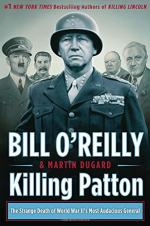|
This section contains 535 words (approx. 2 pages at 400 words per page) |

|
Killing Patton Summary & Study Guide Description
Killing Patton Summary & Study Guide includes comprehensive information and analysis to help you understand the book. This study guide contains the following sections:
This detailed literature summary also contains Topics for Discussion on Killing Patton by Bill O'Reilly.
Killing Patton is the story of the famous general’s role in the last months of World War II. General Patton was the commander of America’s Third Army. General Eisenhower, the Supreme Allied Commander in Europe, had assigned Patton to report directly to General Omar Bradley, a decision that roiled the outspoken Patton who considered Bradley inferior to him as a soldier and as a commander.
Everyone from Eisenhower to Hitler admired the courage and aggressiveness that Patton displayed. However, Patton was difficult to deal with and he had no grasp of the importance of being politically correct. He railed against the decisions made by Eisenhower and Bradley. He publicly disparaged Russia, who was an ally, and considered the spread of communism the next threat to the world.
Patton led the U.S. Third Army valiantly in famous battles including the siege on Fort Driant, the fight for Meuse and the race to Berlin which was dubbed the Battle of the Bulge by U.S. media. Through it all, Patton was an uplifting presence and inspiration to his men. His patriotism and love of country was only superseded by his love and admiration for his soldiers – his courageous soldiers. Nothing pulled at his heart more than seeing his men killed or wounded. Patton famously rode his open air jeep from one post to another in support of his soldiers. He visited the wounded soldiers who he considered the real heroes of the war with heavy heart.
In the final throes of the war, Patton had become an all-American hero. He was adored by soldiers and public alike. He was on the cover of Time magazine during those final days. However, the public opinion of Patton did a reversal when a reporter recounted several incidents in which Patton encountered soldiers who he deemed less than valorous; in fact, he considered them cowards. He talked with a soldier who was hospitalized because he was suffering from shot nerves and exhaustion. The medical staff was appalled when Patton slapped the soldier and ordered him to get himself back on the battlefield. He had a similar reaction to another soldier who was suffering from battle fatigue. The public demanded that he be removed from his command. Eisenhower severely reprimanded Patton for his behavior but he wasn’t about to fire him. He needed Patton who was known as the most aggressive of all his commanders to assure that the U.S. and Allies were victorious.
As the war was winding down, the command of the Third Army was taken from Patton which was a devastating blow to him. While he was planning a future without war and without being part of the military, he was involved in a serious auto accident in which his legs were paralyzed. Patton didn’t want to live like a vegetable and it was his need to contribute that undoubtedly led to his death a short time later. There were rumors that the Russians were conspiring with the head of the U.S. government’s OSS unit to kill Patton. There was never any proof of such a conspiracy although many military and political leaders did not cry at his funeral.
Read more from the Study Guide
|
This section contains 535 words (approx. 2 pages at 400 words per page) |

|



